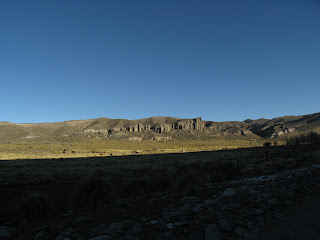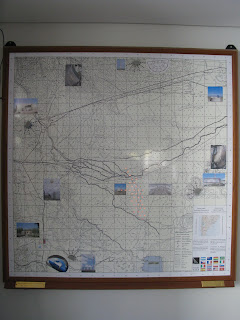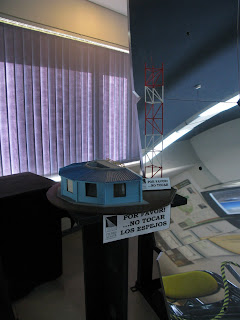I'd like to thank you for following along, while Malargue in many ways isn't as exciting as Antarctica, I've enjoyed my time here and I hope you found some enjoyment in the blog.
Our installation was a success, had we more time we would have done more things and perhaps done some things differently, but we're taking data which is what counts. If the science works out, there will be many more trips to Argentina in the years to come as it's possible they would install dozens of setups similar to the one we put in. I should know how that all goes in a few months.
I forgot to share some photos of Malargue. In this photo you can see the hotel that I stayed at, the Rio Grande, as well as a line of cars waiting to getting compressed natural gas from the gas station. A line forms each morning waiting for the tanker to make a delivery because the station sells out everyday. I've seen people just leave their cars there for hours just to save their place in line. There isn't really a line for the diesel or gasoline, but we did find two gas stations in Mendoza that were out of gasoline.

Here you can see one of the many gomerias in Malargue and the surrounding country. These tire shops are open 24/7 and look like the fly by night operations, but apparently are quite reasonably priced and useful given the road conditions.

Here's what a stretch of road looks like going out to Coihueco.

Here you can see Cerro Sosneado from Coihueco. Sosneado is 17,000 feet tall, however 5000 feet of it are included in the land that I am standing on. At 17,000 feet it is about half a mile taller than Mount Whitney.

This shot is again from Coihueco and you can see Cerro Sosneado. I believe the pass to the left of Sosneado is the pass that the Uruguayan flight took carrying the rugby players that crashed into the Andes in 1972. It's a pretty amazing story, but the survivors ended up resorting to cannibalism but 1/3 of the people involved were eventually rescued when a group of the survivors went looking for help. It's been remade into a few films, but Alive is one of the better films on the story.

Sunset at Coihueco.

If you look along the top of the fence on the very left of the photo you may be able to see Los Leones, the other site that I went to. (Don't look too hard, I've zoomed in a bit in the next photo).

My guess is you probably can't see it, so here it is zoomed in a bit. If you look carefully in the middle of the photo, you'll see a few white dots, I believe those are the buildings at Los Leones.

The last couple days at Coihueco we were spoiled by the support crew as they prepared two amazing lunches for us. Definitely the best food I've had since I've been here, though the food in general has been pretty good.

We were checking out our system by looking at the passage of the sun across our feed. Here you can see the reflection of the sun off of our dish on the face of our feed.

Here's a shot of us determining where exactly the dish is pointing using a theodolite.

A shot of the final setup. The inside of the electronics hut in the background is in the next photo.




A shot of the highest mountain in the Americas, the Southern Hemisphere, the Western Hemisphere, and/or outside of the Himalayas. It is also the tallest non-technical mountain in the world meaning you can walk up it with an oxygen bottle without ropes or axes.

A view of Aconcagua just below the wingtip from the flight from Mendoza to Santiago. At about 22,000 feet tall, it's over a mile shorter than Everest.





































